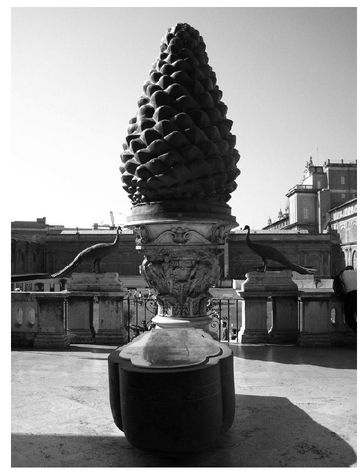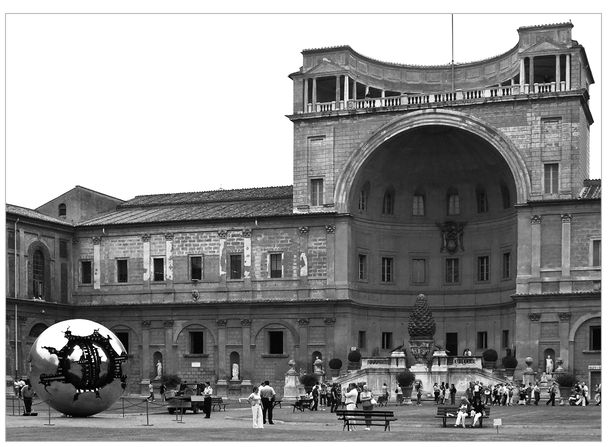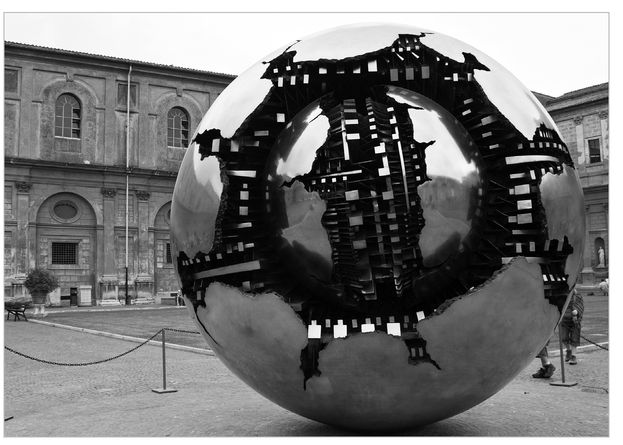The Source Field Investigations (9 page)
Read The Source Field Investigations Online
Authors: David Wilcock

Given this history, and the widespread use of the omphalos and baetyl on Greek and Roman coins, we can understand why the Romans placed a giant bronze statue of a pinecone in the center of Saint Peter’s in the Vatican, and built a pinecone into the pope’s staff. The pope is supposed to be God’s anointed messenger, and in the ancient traditions, this requires an “awakened” pineal gland. A quick Google Images search proves the staff I show in
The 2012 Enigma
is not the only one with a pinecone in it that the pope carries.
The 2012 Enigma
is not the only one with a pinecone in it that the pope carries.
The gigantic bronze pinecone at the Vatican is much taller than a human being, and is surrounded by Egyptian symbols. This statue fixed the Vatican as the center of the Roman Catholic world—the
axis mundi—
in accordance with the ancient tradition. Two lions guard the statue at its base—sitting on pedestals that are inscribed with Egyptian hieroglyphics. The statue itself is flanked with two birds that almost certainly represent the Egyptian Bennu/phoenix, but none of this is explained. Behind the looming pinecone statue lies an open Egyptian-style sarcophagus, similar to what is found in the King’s Chamber of the Great Pyramid. Elsewhere in the Vatican we find Egyptian obelisks—with Christian symbols apologetically included on their tops.
axis mundi—
in accordance with the ancient tradition. Two lions guard the statue at its base—sitting on pedestals that are inscribed with Egyptian hieroglyphics. The statue itself is flanked with two birds that almost certainly represent the Egyptian Bennu/phoenix, but none of this is explained. Behind the looming pinecone statue lies an open Egyptian-style sarcophagus, similar to what is found in the King’s Chamber of the Great Pyramid. Elsewhere in the Vatican we find Egyptian obelisks—with Christian symbols apologetically included on their tops.

View behind Vatican pinecone, showing open Egyptian sarcophagus with protective Plexiglas cover to stop people from lying in it.
This massive bronze pinecone is found in the Court of the Pigna, or Court of the Pinecone—at the northern end of the great Renaissance Belvedere Courtyard in Saint Peter’s. To the south, we find Pope Pius VII’s Braccio Nuovo. Eastward we see the Chiaromoni Gallery. Pope Innocent VIII’s palazzetto is to the north, and Pope Sixtus V’s Apostolic Library galleries are to the west. This huge pinecone was cast in the first or second century A.D., by Publius Cincius Salvius—who inscribed his name on the base. Near the end of the eighth century, it was moved directly into the center of the entrance hall in the medieval Saint Peter’s. It wasn’t dismantled and moved into its current position until 1608.
21
21

The Vatican Court of the Pinecone, showing giant pinecone statue (right) and bronze “sphere within sphere” sculpture (left), stylized much like an eye.
Obviously, the early Church fathers felt the pinecone was an extremely important symbol if they placed it so prominently in the Vatican. Further clues may be found in the Bible—where Jesus said, “The light of the body is the eye: if therefore thine eye be single, thy whole body shall be filled with light.” (Matthew 6:22)
22
The Court of the Pinecone also has an enigmatic “sphere within sphere” sculpture at the center. Various images seem to be conveyed, including the shell of an egg cracking open, the possible idea of two planets colliding together, and the concept of hidden gears and machinery being exposed under the surface of the spheres. The two spheres are offset from each other by ninety degrees, and various physics models have suggested we must make an angular turn like this—what they call an “orthogonal rotation”—to enter into higher dimensions. Intriguingly, this sculpture also looks like a stylized eye—which fits with the idea of the pinecone representing the pineal gland or “third eye.”
22
The Court of the Pinecone also has an enigmatic “sphere within sphere” sculpture at the center. Various images seem to be conveyed, including the shell of an egg cracking open, the possible idea of two planets colliding together, and the concept of hidden gears and machinery being exposed under the surface of the spheres. The two spheres are offset from each other by ninety degrees, and various physics models have suggested we must make an angular turn like this—what they call an “orthogonal rotation”—to enter into higher dimensions. Intriguingly, this sculpture also looks like a stylized eye—which fits with the idea of the pinecone representing the pineal gland or “third eye.”

Close-up view of peculiar bronze sculpture in Vatican Court of the Pinecone, suggesting a cracked egg and hidden machinery underneath.
Islamic tradition is also built around a sacred stone—the Ka’aba—that is the central object of devotion for the pilgrimage to the holy land of Mecca. It also is the
axis mundi
of the Islamic world, since every Muslim in the world prays toward this location. A small area of the stone is exposed for the pilgrims to kiss, and this area is surrounded by a polished metallic brace that looks just like a vertical, stylized third eye. The Ka’aba may therefore be another representation of the pineal gland, in further accordance with the ancient tradition. Ireland also has cult stones dating back to around 200 B.C. that fit the pattern—and the Turoe Stone in County Galway looks just like the omphalos, Benben, shiva lingam and baetyl, with stylized, firelike waves of energy carved across its surface.
23
The Written Legendsaxis mundi
of the Islamic world, since every Muslim in the world prays toward this location. A small area of the stone is exposed for the pilgrims to kiss, and this area is surrounded by a polished metallic brace that looks just like a vertical, stylized third eye. The Ka’aba may therefore be another representation of the pineal gland, in further accordance with the ancient tradition. Ireland also has cult stones dating back to around 200 B.C. that fit the pattern—and the Turoe Stone in County Galway looks just like the omphalos, Benben, shiva lingam and baetyl, with stylized, firelike waves of energy carved across its surface.
23
The written history of the pineal gland as our possible gateway to the Source Field, where it is discussed without any veiled symbolism, begins with the work of Pythagoras and Plato—as the occultist Helena Blavatsky explained. When she brings up “the Mysteries,” she is referring to an allegedly hidden tradition of secrets that have been handed down from ancient Egypt and other civilizations in the distant past. Apparently there are “mystery schools” that have continued teaching these ancient traditions through to the present day.
The key to the whole Pythagorean system, irrespective of the particular science to which it is applied, is the general formula of unity in multiplicity, the idea of the One evolving and pervading the many. . . . Pythagoras called it the Science of Numbers. Pythagoras taught that this science—the chief of all in occultism—was revealed to men by “celestial deities,” those godlike men who were the Divine Instructors of the Third Race. It was first taught to the Greeks by Orpheus, and for centuries made known only to the “chosen few” in the Mysteries. . . .
In his
Life of Pythagoras,
Iamblichus repeats the statement of Plato that the study of the science of Numbers tends to awaken that organ in the brain that the ancients described as the “eye of wisdom”—the organ now known to physiology as the pineal gland. Speaking of the mathematical disciplines, Plato says in
The Republic
(Book VII), “the soul through these disciplines has an organ purified and enlightened, an organ better worth saving than ten thousand corporeal eyes, since truth becomes visible through this alone.”
24
Life of Pythagoras,
Iamblichus repeats the statement of Plato that the study of the science of Numbers tends to awaken that organ in the brain that the ancients described as the “eye of wisdom”—the organ now known to physiology as the pineal gland. Speaking of the mathematical disciplines, Plato says in
The Republic
(Book VII), “the soul through these disciplines has an organ purified and enlightened, an organ better worth saving than ten thousand corporeal eyes, since truth becomes visible through this alone.”
24
According to the prolific and controversial Masonic scholar Manly Palmer Hall, Freemasonry traces itself back to these same Egyptian mystery schools. He also claims the biggest secret of Freemasonry is the regeneration of the human being into a Divine state—through the awakening of the pineal gland. Each of the thirty-three degrees of Masonry correspond to one of the vertebrae in the human spine—as the kundalini fire rises up to merge with the pineal gland.
The exact science of human regeneration is the Lost Key of Masonry, for when the Spirit Fire is lifted up through the thirty-three degrees, or segments of the spinal column, and enters into the domed chamber of the human skull, it finally passes into the pituitary body (Isis), where it invokes Ra (the pineal gland) and demands the Sacred Name. Operative Masonry, in the fullest meaning of that term, signifies the process by which the Eye of Horus is opened.
E. A. Wallis Budge has noted that in some of the papyri illustrating the entrance of the souls of the dead into the judgment hall of Osiris, the deceased person has a pinecone attached to the crown of his head. The Greek mystics also carried a symbolic staff, the upper end being in the form of a pinecone, which was called the thyrsus of Bacchus. . . . In the human brain there is a tiny gland called the pineal body, which is the sacred eye of the ancients, and corresponds to the third eye of the Cyclops. Little is known concerning the function of the pineal body, which Descartes suggested (more wisely than he knew) might be the abode of the spirit of man. As its name signifies, the pineal gland is the sacred pinecone in man—the eye single, which cannot be opened until CHiram (the Spirit Fire) is raised through the sacred seals [or chakras,] which are called the Seven Churches in Asia.”
25
25
Hall gave additional information into this deep Masonic secret in another book,
The Occult Anatomy of Man
.
The Occult Anatomy of Man
.
The Hindus teach that the pineal gland is the third eye, called the Eye of Dangma. It is called by the Buddhists the all-seeing eye, and is spoken of in Christianity as the eye single. . . . The pineal gland is supposed to secrete an oil, which is called resin, the life of the pine tree. This word [
resin
] is supposed to be involved in the origin of the Rosicrucians, who were working with the secretions of the pineal gland and seeking to open the eye single; for it is said in scripture: “The light of the body is the eye: if therefore thine eye be single thy whole body shall be filled with light.” . . .
resin
] is supposed to be involved in the origin of the Rosicrucians, who were working with the secretions of the pineal gland and seeking to open the eye single; for it is said in scripture: “The light of the body is the eye: if therefore thine eye be single thy whole body shall be filled with light.” . . .
[The pineal gland] is a spiritual organ which is later destined to be what it once was, namely a connecting link between the human and the divine. The vibrating finger on the end of this gland is the rod of Jesse and the scepter of the high priest. Certain exercises as given in the Eastern and Western mystery schools cause this little finger to vibrate, resulting in a buzzing, droning sound in the brain. This is sometimes very distressing, especially when the individual who experiences this phenomena, in all too many cases, knows nothing about the experiences through which he is passing.”
26
26
It appears the Freemasons and other secret societies may have also referred to the awakened pineal gland as the Philosopher’s Stone. Manly Palmer Hall’s description is but one of many that make this strong suggestion—when you consider the context.
The Philosopher’s Stone is an ancient symbol of the perfected and regenerated man whose divine nature shines forth. . . . As the rough diamond is dull and lifeless when first removed from the black carbon, so the spiritual nature of man in its “fallen” state reveals little, if any, of its inherent luminosity. . . . He who possesses the Philosopher’s Stone possesses Truth, the greatest of all treasures, and is therefore rich beyond the calculation of man; he is immortal because Reason takes no account of death and he is healed of Ignorance—the most loathsome of all diseases.
27
27
Rudolf Steiner, a well-known scholar of the esoteric mystery schools, argued that the legend of the Holy Grail—a chalice filled with the “waters of life” or “elixir of immortality”—is yet another symbolic reference to the pineal gland.
28
The bowl of the Grail chalice is shaped like a pineal gland in most historic illustrations—but upside down compared to everything else we’ve been discussing so far. A recent Steiner compilation entitled
The Mysteries of the Holy Grail
establishes detailed connections between the Grail legends and the pineal gland.
28
The bowl of the Grail chalice is shaped like a pineal gland in most historic illustrations—but upside down compared to everything else we’ve been discussing so far. A recent Steiner compilation entitled
The Mysteries of the Holy Grail
establishes detailed connections between the Grail legends and the pineal gland.
The [Holy] Grail is also located within each of us, in the castle of the skull, and can nourish our subtlest perceptions in a way that dispels all but the most refined material influence. . . . Steiner is referring here to the pineal gland in the brain. . . .
29
29
The legends of the “Cosmic Egg,” “World Egg” and particularly the “Orphic Egg” also appear to be pineal gland references. The Orphic Egg is pictured with a serpent wrapped around it, and the shape of an egg is similar to the shape of the pineal gland. Manly Palmer Hall again gives insight into the meaning of this ancient symbol, hinting at a connection with the pineal gland—when you consider his other statements as well.
Other books
Needle in a Haystack by Ernesto Mallo
Unleashed by David Rosenfelt
Love and Money by Phyllis Bentley
Outside the Dog Museum by Carroll, Jonathan
A Lady And Her Magic by Tammy Falkner
The Promise of Surrender by Liliana Hart
Some Kind of Fairy Tale by Graham Joyce
King of Cuba by Cristina Garcia
Dreams of Glory by Thomas Fleming
